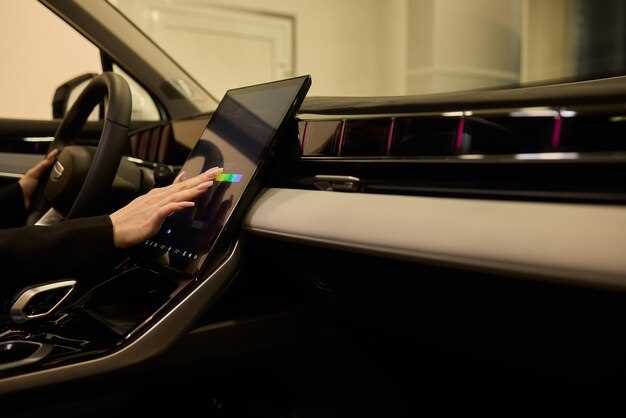
In today’s fast-paced world, integrating technology into our daily lives has become essential, especially when it comes to driving. With the rise of smartphones, features like Apple CarPlay and Android Auto provide seamless connectivity between your mobile device and your Ford vehicle. These platforms enhance your driving experience by allowing you to access your favorite apps, navigation tools, and music services directly from your car’s infotainment system.
Apple CarPlay and Android Auto enable you to use your smartphone in a safer and more efficient manner. Just by connecting your device to the car, you can easily manage calls, send messages, and listen to music without needing to pick up your phone. This feature not only minimizes distractions but also keeps you focused on the road ahead, which is crucial for your safety and that of others.
Understanding how to utilize these systems effectively can significantly enhance your driving experience. With detailed instructions and tips for both Apple and Android users, this article will guide you through everything you need to know to make the most of Apple CarPlay and Android Auto in your Ford vehicle.
Connecting Your Smartphone to Ford’s Infotainment System
Connecting your smartphone to Ford’s infotainment system allows for seamless integration of your device with the vehicle, enhancing your driving experience. The process is straightforward, whether you’re using Apple CarPlay or Android Auto.
Step 1: Prepare Your Smartphone
Before starting the connection, ensure that your smartphone has the necessary application installed. For Apple users, make sure your iPhone is running iOS 13 or later to utilize Apple CarPlay. For Android users, ensure your device is equipped with Android 5.0 (Lollipop) or higher to access Android Auto.
Step 2: Connect via USB
Using a compatible USB cable, plug your smartphone into one of the USB ports in your Ford vehicle. Most Ford models have designated ports for this purpose, typically located in the center console or dashboard. Once connected, the infotainment system should automatically detect your device.
Step 3: Allow Permissions
Upon initial connection, you may need to grant permissions on your smartphone for the infotainment system to access certain features. Follow the on-screen prompts on your smartphone to allow access to apps, contacts, and notifications.
Step 4: Accessing the Infotainment System
Once permissions are granted, the Ford infotainment system will display your smartphone’s interface. You can now navigate through your apps using the touchscreen or voice commands. Common functions include accessing maps, music, messages, and calls.
Step 5: Seamless Experience
The integration provides a hands-free experience, enabling safer driving. Use voice-activated commands to control navigation or adjust music, ensuring that your attention remains on the road.
Following these steps will help you effortlessly connect your smartphone to Ford’s infotainment system, maximizing connectivity and convenience while driving.
Customizing App Settings for Optimal Use While Driving

When integrating your smartphone with Apple CarPlay or Android Auto in your Ford, customizing app settings is essential for a seamless and safe driving experience. Each platform offers various settings that can enhance functionality while minimizing distractions.
Set Up Do Not Disturb Features
Both Apple CarPlay and Android Auto allow you to enable a “Do Not Disturb” mode, which can help limit notifications while driving. This feature minimizes interruptions by silencing incoming messages and calls, allowing you to focus on the road. Ensure that you configure these settings before embarking on your journey.
Prioritize Frequent Apps
Customize the layout of your apps to prioritize those you use most frequently. In CarPlay, you can rearrange the app icons, placing navigation and music apps within easy reach. Similarly, Android Auto enables you to select which apps appear on the screen, ensuring quick access to their features without unnecessary scrolling.
Adjust Navigation Preferences
Both systems offer customizable navigation settings. Opt to use voice commands for hands-free operation, reducing the need for physical interaction with your smartphone. Set preferred routes, avoid tolls, or choose to avoid highways, depending on your driving style and preferences. This can significantly enhance your driving efficiency while keeping you attentive to the road.
Manage Media and Audio Settings
To improve the audio experience while driving, adjust your media settings to control playback sources and volume levels. With CarPlay, you can customize playlist access and feature your favorite streaming services. Android Auto also allows you to link directly to media apps, giving you quick access to controls while minimizing distractions.
Control Voice Assistants
Both platforms come equipped with voice assistants–Siri for CarPlay and Google Assistant for Android Auto. Customize the assistant settings to respond to your preferences, such as adjusting wake words and activation methods. This feature boosts convenience and allows you to access information without taking your hands off the wheel.
Review Permissions and Settings
Regularly check the permissions awarded to your apps. Limiting unnecessary app permissions can prevent distractions. For example, disable social media notifications or limit map applications to only display essential driving info. This practice enhances safety and keeps you focused on the road ahead.
By customizing app settings for Apple CarPlay and Android Auto, you optimize your smartphone’s functionalities and create a more efficient and safer driving environment. Prioritizing ease of access and minimizing distractions ultimately leads to a better driving experience.
Troubleshooting Common Connectivity Issues with CarPlay and Android Auto

When using Apple CarPlay or Android Auto in your Ford vehicle, you might encounter a few connectivity issues. These can hinder your experience, but many problems can be resolved quickly. Here are common issues and their solutions.
First, ensure that your smartphone is compatible with CarPlay or Android Auto. Check the manufacturer’s list for supported devices. If your smartphone is compatible, ensure that your operating system is updated to the latest version.
Next, verify that your smartphone’s Bluetooth and Wi-Fi are turned on. For Android Auto, connect your smartphone to your vehicle using a high-quality USB cable, preferably the original one provided by the manufacturer. If you are using a wireless connection, confirm that your vehicle’s system supports it and that both devices are paired properly.
If connectivity is still an issue, try restarting both your smartphone and your Ford’s infotainment system. This can often clear glitches that may be preventing a proper connection. Additionally, ensure that any unnecessary apps running in the background on your smartphone are closed, as they can consume resources and affect performance.
If you still face issues, try re-installing the CarPlay or Android Auto apps on your smartphone. For Android devices, you may also want to clear the app’s cache by going to the settings and selecting the app, then clearing the cache. Lastly, check your vehicle’s infotainment system for any available software updates to ensure optimal compatibility and performance.
If problems persist, consider consulting the user manual for your Ford or contacting customer support for further assistance. Most issues can be resolved with a few simple troubleshooting steps, allowing you to enjoy your smartphone’s features seamlessly while driving.



